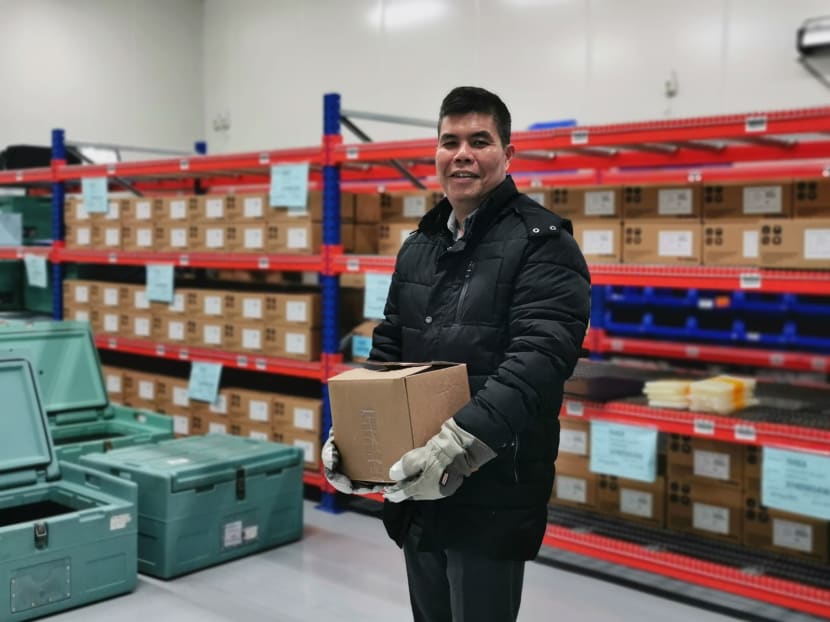The Big Read in Short: The challenges faced by S’porean middle-age workers
Each week, TODAY’s long-running Big Read series delves into the trends and issues that matter. This week, we look at the challenges facing workers in their 40s and 50s who were singled out for additional Government support during the recent Budget statement. This is a shortened version of the feature.

Being laid off has become increasingly common among older workers and this is largely due to skills redundancy, labour economists and human resource experts told TODAY.
Each week, TODAY’s long-running Big Read series delves into the trends and issues that matter. This week, we look at the challenges facing workers in their 40s and 50s who were singled out for additional Government support during the recent Budget statement. This is a shortened version of the feature, which can be found here.
SINGAPORE — At 49, Jeff (not his real name) has been written off by potential employers as “too old, too expensive and too experienced”.
Since he lost his job in October last year, Jeff, who was retrenched from a multinational manufacturing firm, has sent out over 500 job applications to numerous companies but has so far received only one response.
This is even after he began applying for jobs that offered about S$2,000 a month, which is less than half of his S$5,900 monthly paycheck prior to being laid off.
The company which replied told him that it was concerned his prior experience and past salary would mean that he would leave for greener pastures should he receive a better offer down the road.
But Jeff, who has to support his wife, two children and his parents, said he has no such aspirations.
“I have worked for 26 years and so far I’ve only joined three companies. I’m not a job hopper, I’m not the kind to leave for higher pay… It’s very simple, I just need a job to move on with my life,” said Jeff, who is awaiting a second interview with the company which got back to him.
Like Jeff, workers in their 40s and 50s today face greater job insecurity than ever before due to Singapore’s ongoing economic restructuring efforts to raise skills and productivity, as well as disruptions caused by rapid technological changes.
Traditionally, those in this age range would be entering the prime of their careers.
But alas, times are different now. Some of them, in fact, find that they have been displaced because their skills are no longer relevant in a knowledge-based economy.
And that is not the only reason. The experiences of mid-career or middle-age workers like Jeff as well as several others interviewed by TODAY suggest that there are other factors at play, causing some of these workers to struggle to hold on to their jobs or seek new ones. These include ageism and a seniority-based wage system that has left them being deemed as “too expensive” for employers to hire.
This group was singled out in the Budget statement delivered by Deputy Prime Minister and Finance Minister Heng Swee Keat on Feb 18.
Noting the changing nature of jobs as companies restructure, Mr Heng added: “Some workers in their 40s and 50s have not seen any job or career changes since leaving school, or had the chance to upskill earlier. But they are now facing greater competition, from younger workers and workers overseas. I understand their anxiety.”
To help these workers, Mr Heng announced a SkillsFuture Mid-Career Support Package.
DBS senior economist Irvin Seah expects these new measures to largely benefit the group of older professionals, managers, executives and technicians (PMETs) who make up a large percentage of the workforce, and are more vulnerable to economic disruptions.
On the need to lend this group of workers a helping hand, Mr Seah noted that the retrenchment rate for this group of workers is relatively higher than other segments. Middle-age PMETs also typically have higher financial burdens, he said.
This is unlike younger workers or lower-skilled workers who would not experience such a drastic cut in their salaries or confront as steep a learning curve should they need to switch to a different industry, he added.
THE THREAT OF IRRELEVANCE
Being laid off has become increasingly common among older workers and this is largely due to skills redundancy, labour economists and human resource experts told TODAY.
The skills in demand have changed drastically since workers who are now in their 40s and 50s entered the workforce. Unlike in the past, workers could no longer get by with little IT skills and education, so older employees often have to play catch up in a rapidly evolving economy, the experts said.
The rise of computers and greater automation have also replaced many of the routine and manual tasks historically performed by low-skilled workers, said Dr Kelvin Seah, a senior lecturer at the National University of Singapore’s Department of Economics.
“This means that those whose jobs are routine or which rely on manual labour are now at greater risk of being displaced by automation,” he added.
This phenomenon is certainly not unique to Singapore. Across the globe, middle-age workers are increasingly being displaced as digitisation and mechanisation gradually render many skills redundant.
It is therefore unsurprising that so much emphasis has been placed in Singapore on skills upgrading and retraining as, according to career strategist Adrian Choo, it is the “only way” to ensure that workers remain ahead of the curve.
“The biggest worry is that because of the global nature of talent mobility, someone else cheaper or better can come in to do our job… There’s always going to be someone cheaper, better or faster than you. So that’s why all we can do is to continue sharpening the saw,” he said.
That being said, labour experts acknowledged that there could be some element of ageism that hinders middle-age workers from finding new employment after they have been retrenched.
OTHER CHALLENGES FOR MIDDLE-AGE WORKERS
For Siew Hua (not her real name), a lack of educational qualifications has left her with limited options as she struggles to find work after being laid off from her job last September.
The 54-year-old had worked as a stagehand at an advertising production house for 10 years, but was let go when business slowed down and the company was able to find ways to cut down on its manpower needs.
She told TODAY in Mandarin that the only work she could secure so far was a temporary job packing food for barbecued meat retailer Bee Cheng Hiang during the Chinese New Year period this year.
For 40-year-old Laura (not her real name), educational qualifications or a lack of relevant skills had nothing to do with her losing her job.
She told TODAY that she was let go from her job earlier this year at an international finance firm. In an effort to cut costs, the company had combined two roles and chose to replace her with a foreign employee who was brought over from another branch in the region.
When Laura asked her boss why she was not retained, he told her that he had evaluated both their performances and felt the foreign employee was a better fit for the company.
But Laura, who had been with the company as a financial planner for six years, was not convinced.
She has approached the Ministry of Manpower (MOM) and the Tripartite Alliance for Fair and Progressive Employment Practices (Tafep) about her case.
MOM has come down hard on companies which treat Singaporeans unfairly in the workplace.
Between 2014 and 2018, Tafep followed up on about 2,000 complaints. Action was taken against employers in 680 cases, with 280 of them resulting in debarment from hiring new foreign workers.
Apart from cracking down on companies with discriminatory hiring practices, the Government has also tightened the foreign manpower regime in recent years.
At this year’s Budget, for example, Mr Heng announced that the Government will be reducing the quota for skilled foreign workers in the construction, marine shipyard and process sectors over the next three years to encourage firms to hire more Singaporean skilled workers and technicians.
HOW RETRAINING CAN HELP
Despite the challenges faced by mid-career workers, some have managed to turn their personal situation around by undergoing retraining. This, in turn, has opened new doors for them.
Mr Simon Wee, now 59, found an unexpected lifeline in 2009 when a coffee shop in Chinatown took him in and taught him how to brew coffee.
Before this, he had been drifting from one temporary job to another as the economy was still reeling from the global financial crisis in 2008.
Mr Wee, who now works at Attap House restaurant at Mapletree Business City, said that when he first got the job, he did not think that brewing coffee was something he would be interested in.
“I had to wake up at six in the morning to learn how to brew coffee… it was not easy but I knew I had to adapt because there were no jobs around at the time,” he told TODAY in Mandarin.
But after close to a decade of doing it, he has come to enjoy the work, especially when his regular customers compliment him.
For Mr Kenneth Lee, 56, attending Workforce Singapore’s (WSG) Professional Conversion Programme helped him to advance further his career goals, and ensure that his skills remained relevant for him to stay in the logistics sector.
“To be honest, it is not easy for a middle-age man like myself to switch industries, especially in this digital economy… Fortunately I have a superior who is willing to mentor, guide and listen (to me),” said Mr Lee, who is now an assistant manager in the healthcare division at ST Logistics.

The training that he received also gave him the necessary qualifications and technical skills to take on new job opportunities in areas beyond the logistics sector.
While success stories abound, the path to finding the right training programmes is not always clear-cut for other middle-age workers.
Ms Lily Teo, 55, who was among those retrenched by travel retailer DFS last year, said she would not mind taking up retraining courses to upgrade her skill set.
However, she said she is unsure which courses would be most suitable for her.
Speaking to TODAY, a former cleaner at a childcare centre, who wanted to be known only as Ani, also said she had tried to take up SkillsFuture courses around five years ago. However, Ani, who is 60 now, said she did not understand the course content due to her limited grasp of English.
EVOLVING SKILLSFUTURE TO MEET WORKERS’ NEEDS
Earlier this week, Education Minister Ong Ye Kung acknowledged that more guidance is needed to help individuals find the courses that they need the most.
“We started off ‘letting a thousand flowers bloom’, so we have many courses but sometimes that also causes some confusion, where an individual may not know where and what to learn,” he told reporters on the sidelines of a tour at the National Trades Union Congress (NTUC) LearningHub.
Mr Ong added that courses offered under SkillsFuture — which was launched in 2015 — should evolve to offer more variety as well as become targeted at the needs of workers and companies.
Responding to TODAY’s queries on some issues faced by mid-career workers seeking retraining, a SkillsFuture spokesperson said jobseekers can seek in-person advice from its SkillsFuture Advice workshops which are held at selected National Library branches, community centres and company offices islandwide.
These workshops are conducted in the four national languages.
Separately, a WSG spokesperson noted that many of its programmes are conducted in English, since it is “the language of business for many jobs in Singapore”.
“However to reach out to as many Singaporeans as possible we adopt a wide range of different and targeted approaches tailored to each audience segment, including publicity and engagement efforts in all four national languages,” the spokesperson added.
The SkillsFuture spokesperson noted that with the additional S$500 SkillsFuture credit for mid-career workers, Singaporeans aged between 40 and 60 can use them for career transition programmes offered by the Continuing Education and Training Centres. Career advisory services will also be available to participants of the programmes.
Labour Member of Parliament Zainal Sapari, who is NTUC’s assistant secretary-general, said that both WSG and the Employment and Employability Institute have ramped up their efforts in advertising the services that they offer.
Noting that workers need to take the first steps themselves, Mr Zainal said: “The information is all out there, on who they can approach (for help). I’m not sure what more can be done other than the mid-career workers approaching these organisations for guidance.”
At the end of the day, workers need to count on their skills — not so much their experience — in order to be sought after in today’s economy, employers say.
Kimly Construction director Louis Khoo said: “Relevant experience is subjective to the different companies and is not necessarily future-proof, and being willing to take a pay cut does not matter if your skills and knowledge are outdated.”
He added: “Ultimately, any employer would still want to hire someone who can add value to the work and the culture of the organisation.”











